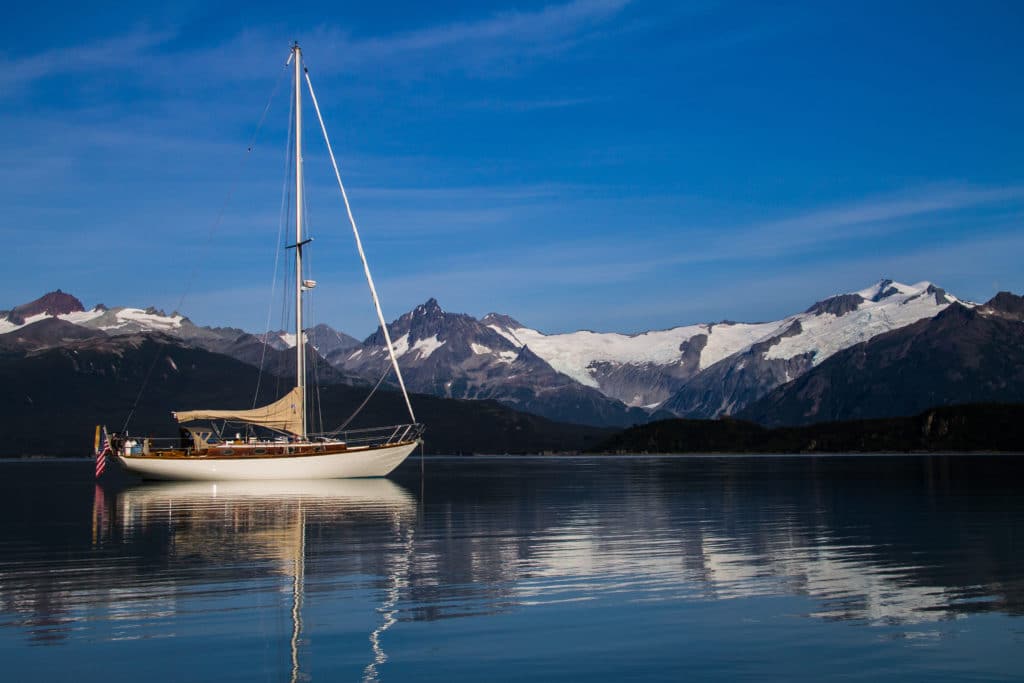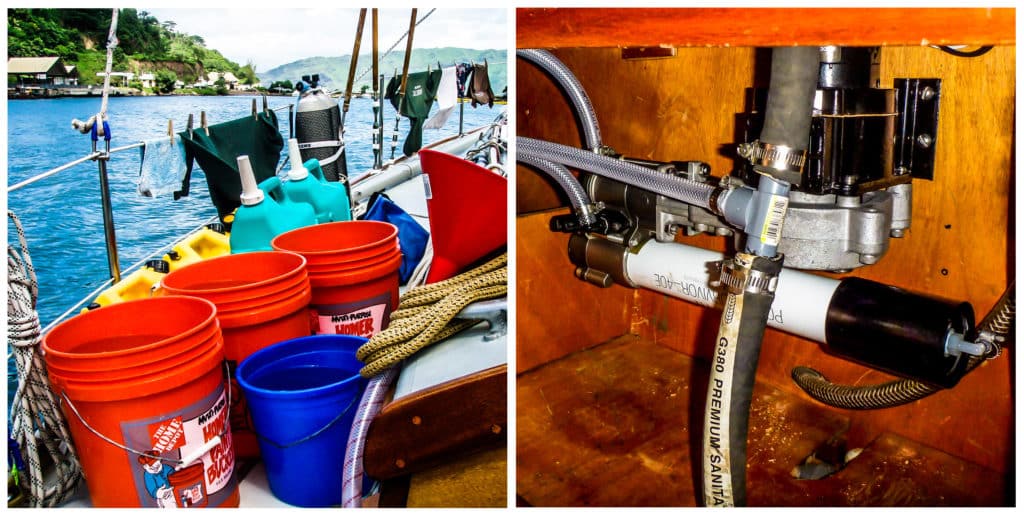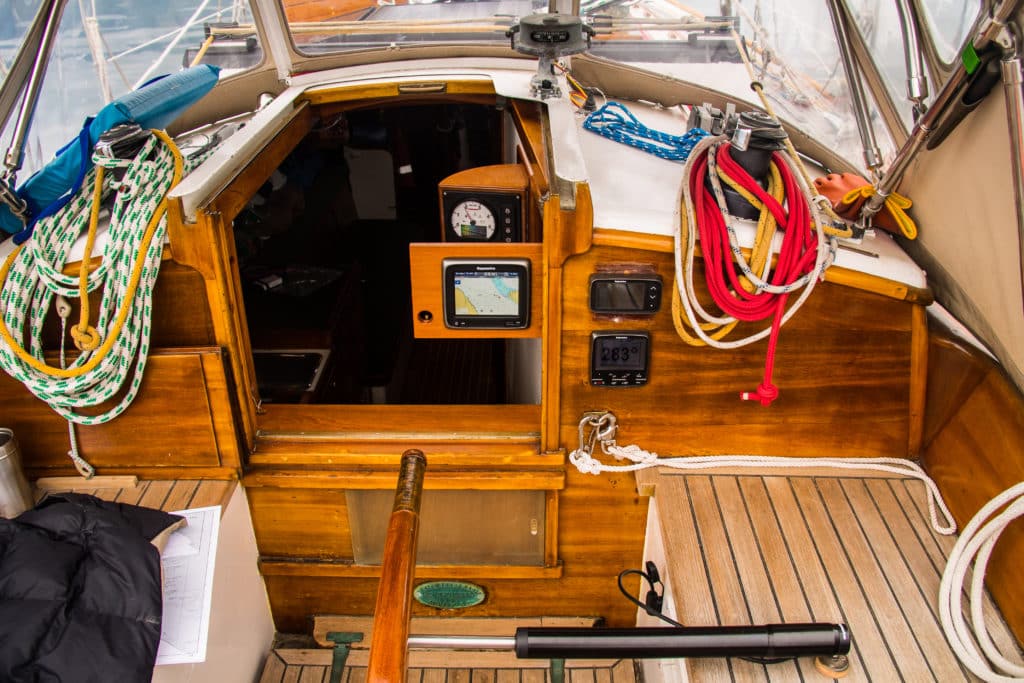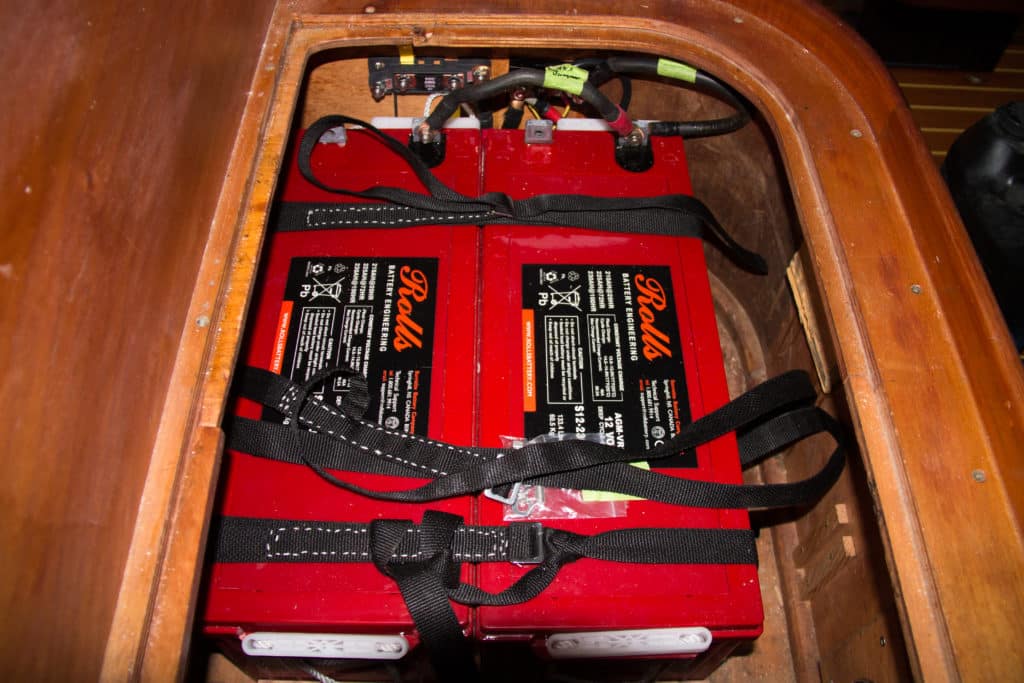
On our circumnavigation, my husband (then boyfriend), Seth, and I often heard ourselves referred to as “the kids on the primitive boat.” I hope we’re still “the kids,” but for better or worse, “the primitive boat” is no longer with us. No, she didn’t sink. We sold her, a couple of years passed, and we bought a replacement, or, you might say, an upgrade.
Celeste, our current boat, and Heretic, the primitive boat, would look like twins in an anchorage, both classic cutters with mahogany cabins. Celeste is a 40-foot Sparkman & Stephens design with a fin keel, built in 1986. Heretic was designed and built by Dave Westphal in 1968 — 20 years earlier — a sleek 38-footer with a full keel. But what really makes one primitive and the other comfortable (in our minds luxurious, after Heretic) are the systems. Heretic had no refrigeration, pressure water, hot water, watermaker, heat, electric anchor windlass, autopilot, chart plotter or generator, and certainly nothing like air conditioning. Her radar worked once or twice in 32,000 miles. For three out of four years our communications were limited to our radio. We lit the cabin solely with kerosene for over a year. Showers were buckets over the side. We both had a great time. I honestly couldn’t imagine a more rewarding circumnavigation, and I was devastated when we had to sell Heretic at the end. So I was equally excited to buy Celeste in 2013. She’d be another Heretic, another home on which to sail to all the world’s most wonderful places. I didn’t realize that she was also remarkably comfortable.
By contemporary standards, Celeste isn’t luxurious. She isn’t a big cat with a washer, dryer and freezer drawers. But we sail and live aboard her, even in cold and remote places like Alaska’s Aleutian Islands, in perfect comfort. And we do it on only 120 amp-hours.
I don’t mean we have a 120 amp-hour battery bank — far from it. We have two Rolls Battery Engineering S12-230 AGM batteries for our house bank, which means a total of 460 amp-hours. We approached Rolls for sponsorship for our Arctic voyage because of its commitment to recycling and sustainability, and also because of its reputation for a durable and long-lasting product. Like most cruisers, we try to make things last. In order to get long life from the batteries, we choose not to drop below a 75 percent depth of discharge — in other words, not to pull more than 25 percent of the bank’s capacity before bringing it back up to full charge. It’s important to charge the batteries fully on each cycle to prevent cell failure.
What this means in practice, besides keeping a steady eye on our battery monitor, is that everything electrical we want on each cycle can use up only about 120 amp-hours. That’s easy on a primitive boat, but how can you do it in comfort?
For a lot of people, the big power draw is refrigeration. Celeste does have refrigeration, but it uses very little electricity. When the compressor runs (which it does infrequently, once cold), it starts with a 4-amp draw (we have a 12V system) that quickly drops to 3, 2, then 1 amp. The compressor is an Engel; its piston is powered by magnetic fields and has very little friction, so once it gets going, it needs almost no power to keep it running. Our icebox is not huge, so the surface area of the cold plate is large compared to the fridge’s volume. We load it from the top so cold air doesn’t escape, and we always keep it full so the already cold items (sodas, beers, condiments) help keep everything else cold.

Watermakers are another big power draw. Why have one, you ask? Starting my circumnavigation at age 20, I was pretty sure we didn’t need one. We couldn’t afford it anyway, Heretic carried 150 gallons, and I was intimidated by what sounded like complex maintenance. We got very fit lugging jerry jugs, and we drank some terrible-tasting water for several months. We paid for water once, when the only other option was a stagnant tank with a dead lizard in it. We almost always showered with buckets of seawater.
On Celeste we have the smallest Katadyn model, the PowerSurvivor 40E. It makes 1.5 gallons per hour, which adds up quite quickly if you’re not lavish about the water you use. Drawing only 4 amps, it is the lowest-draw desalinator out there (barring Katadyn’s manual ones), and perfectly reasonable on our 120 amp-hour budget. On a normal sunny day — even in Alaska — we can run it off our solar panels. Without installing a high-output alternator, you can run it while puttering into an anchorage. And I was wrong to be intimidated by the maintenance; it’s fairly simple. Of course we still fill from shore as well, and we carry jerry jugs as backup, but it’s a comfort to know we’ll never be without good-tasting, sanitary water.
Celeste also has a hot pressure shower in the head. What luxury, especially in cold weather! The pressure water pump is small — only a gallon per minute. The bilge pump that empties the sump draws 2 amps but runs for only a few seconds. To be honest, the batteries are almost always full if we’re using the shower, because heating the water requires either the engine or shore power. Electrical draw is still a consideration, though, if we don’t plan on motoring or being at a dock for several days after taking pressure showers. The showerhead itself helps, having a switch right on it to turn off the water. Using the switch, it’s easy to get wet, turn the water off to lather up, and turn it back on again for a quick rinse. I doubt we use much more than two gallons each — and I have hair below my shoulders. On long passages with little or no engine use, however, we’re still “the kids on the primitive boat,” bathing in buckets of seawater.
For cold-weather sailors, heat is the third major power draw. Forced-air heaters such as our Espar could do serious damage to our shiny new Rolls batteries if we weren’t careful. Celeste’s Espar was already installed when we bought her, and it warms her up quickly and well. To keep our batteries happy, we use it only when the engine is running. Knowing this would be the case, we installed a diesel/kerosene Refleks stove-type heater, obtained from Hamilton Marine (the only North American distributor of the Danish stove). Ours is gravity-fed from a little tank made up by the welders and joiners at Platypus Marine boatyard in Port Angeles, Washington, where we refit Celeste for Alaska. The Refleks heats its immediate surroundings much better than it does the rest of the boat, but the fact that it needs absolutely no electricity makes up for that. When we’re below, we spend most of our time next to it in the dinette anyway.

With LED bulbs now widely available and relatively cheap, cabin lighting on next to no power is easy. And it’s no longer ugly if you choose “warm light” bulbs. All our cabin lights are LEDs, and with all of them on, the battery monitor registers about a 1-amp draw. That’s for the whole boat! We’ve also upgraded our tricolor and anchor light to LEDs; they shine just as brightly as before, use almost no power, and shouldn’t burn out for years. Electronics too have come a long way in a short few years. Our semifunctional 1980s radar on Heretic chewed up power, but our digital radar on Celeste uses about 3 amps when scanning and 1 amp on standby. We can’t have it on all the time with that type of draw, but it’s manageable, and often when it’s foggy it’s also calm, so we’re motoring. The display (which also serves as a chart plotter when we want it) is an LED screen using 0.7 amps at full brightness. As we did on Heretic, we have a Furuno GP32, which displays our GPS coordinates but not a full chart. We use it instead of the radar/chart plotter display on passages to conserve power still further, as it uses only 0.2 amps and we enjoy navigating on paper charts. Our depth sounder/knotmeter also uses about 0.2 amps. Even our tiller’s autopilot (Celeste has tiller steering) averages only 2 amps. That said, we use the autopilot mostly when motoring; for sailing, we still love windvanes. On Heretic we had a sturdy Aries, and we’re very pleased with Celeste’s efficient and streamlined Cape Horn. What makes having an autopilot a luxury to us is the fact that we no longer need to hand-steer every time we turn on the engine. This also means we use the engine more than we did during our primitive Heretic days — at one point on the circumnavigation, we drifted for six days before the wind finally came and we could carry on across the Indian Ocean.
In terms of communications, we’ve come out of the Dark Ages: We actually have some! An AIS receiver built into the VHF is one of our favorite new tools on board, and the batteries hardly notice its little backlit screen; in receive mode it uses about 0.8 amps. We tend not to use the power-hungry SSB that much, now that we have an Iridium phone with an external antenna, Wi-Fi router and firewall. For the last few months of our circumnavigation, we finally got around to using a Pactor modem and SailMail, but now that we have the sat phone, we use OCENS email and weather programs. Getting color, animated, 3-D weather files is a luxury in itself, but maybe even better is the fast and silent delivery of the satellite connection. With the OCENS external antenna, our sat phone has never dropped its signal, and we get everything we need in less than 90 seconds. In terms of power draw, charging the laptop computer is the same as always, but charging the phone consumes a tiny fraction of the power that the SSB and Pactor modem did.

We rarely use all these items at once. At sea, our daily use consists of fridge, tricolor, red nav-station light, Furuno GPS and VHF. Every few days we’ll check the weather and maybe use the watermaker. If it’s foggy and we’re concerned about land or traffic without AIS, we’ll turn on the radar. Coming into a port or anchorage, we’ll turn on the depth sounder and chart plotter. We’re usually motoring into port and therefore charging the batteries anyway. If it’s cold out, we might have the Espar on while we’re motoring. At anchor, we just use the cabin lights, anchor light and fridge. For heat, we light the Refleks. We might turn on the VHF, and we might use the Furuno GPS for its anchor alarm if it’s a rough night. We’ll likely also use our depth sounder in that situation. Before leaving we’ll check the OCENS forecasts again. In other words, our power consumption is very minimal, and yet we’re no longer “the primitive boat.”
That’s how we manage not to pull more than 25 percent of the juice from our Rolls batteries. But how do we charge them back up? We don’t have a diesel or gasoline generator, and we try not to use the engine to charge. Of course every time we motor somewhere, we’re charging. But auxiliary diesels are not designed to be generators, and we want to keep ours going as long as possible, so we use it only to move through the water.
On Heretic we tried flexible solar panels, thin film panels, polycrystalline panels and a wind generator. The wind generator delivered lots of power in the right conditions, but it was almost useless in following breezes, when there’s little apparent wind. Furthermore, once we switched to solar I realized how little I had noticed the wind generator’s noise and propensity to kill curious seabirds. The real reason we switched to solar, though, was that the wind generator kept frying its circuit board, almost certainly because our battery bank was too small (270 amp-hours) to provide enough resistance to prevent a voltage spike in strong gusts. We wouldn’t have that problem with Celeste’s 460 amp-hour bank, so if we ever need more power, we might install a wind generator again. At the moment, however, we’re happy with 200 watts of hard polycrystalline solar panels. We’ve found the polycrystalline panels deliver much more power for their surface area than either flexible or thin film panels, so they’re worth the extra money. On a sunny day in Alaska they’ll deliver about 8 amps, some days more like 10. On Heretic in Australia, we even saw our panels deliver more than their rated output. When it pours rain, Celeste’s solar panels still put in 1.5 amps.
Since we installed our Rolls batteries, we’ve sailed 3,500 miles from Washington state to Alaska’s Aleutian Islands. We’ve never plugged into shore power, though we have motored in and out of anchorages and occasionally made progress in calms. We enjoyed sunshine for two weeks in southeast Alaska, for a couple of days on the Kenai Peninsula, and for a few days on the Alaska Peninsula. Otherwise, we had partly cloudy or fully overcast skies, rain, or fog. In all that time, we never discharged the AGMs more than 20 percent. Before spending a week in Dutch Harbor with rain and clouds and thus almost no charge, we’d never discharged them more than 12 percent. Often they were completely full. Yet Celeste was snug and warm, we used our electronics whenever we wanted, we always had cold beer, and we took hot showers often. With a little planning and modern equipment, it’s easy to have at least comfort, if not luxury, on very little power at all.
Ellen Massey Leonard completed a circumnavigation at age 24 and is now in the midst of a voyage to the Alaskan Arctic. She recounts her sailing at www.gonefloatabout.com.








